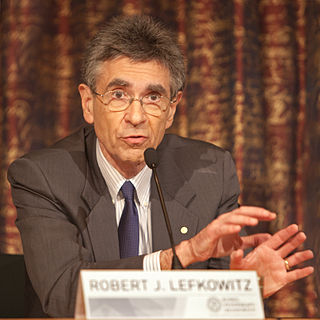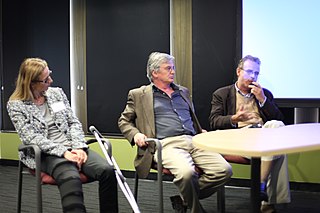
Leishmania is a parasitic protozoan, a single-celled organism of the genus Leishmania that is responsible for the disease leishmaniasis. They are spread by sandflies of the genus Phlebotomus in the Old World, and of the genus Lutzomyia in the New World. At least 93 sandfly species are proven or probable vectors worldwide. Their primary hosts are vertebrates; Leishmania commonly infects hyraxes, canids, rodents, and humans.

Atherosclerosis is a pattern of the disease arteriosclerosis, characterized by development of abnormalities called lesions in walls of arteries. This is a chronic inflammatory disease involving many different cell types and driven by elevated levels of cholesterol in the blood. These lesions may lead to narrowing of the arterial walls due to buildup of atheromatous plaques. At the onset there are usually no symptoms, but if they develop, symptoms generally begin around middle age. In severe cases, it can result in coronary artery disease, stroke, peripheral artery disease, or kidney disorders, depending on which body part(s) the affected arteries are located in the body.

Macrophages are a type of white blood cell of the innate immune system that engulf and digest pathogens, such as cancer cells, microbes, cellular debris, and foreign substances, which do not have proteins that are specific to healthy body cells on their surface. This process is called phagocytosis, which acts to defend the host against infection and injury.
Moses Judah Folkman was an American biologist and pediatric surgeon best known for his research on tumor angiogenesis, the process by which a tumor attracts blood vessels to nourish itself and sustain its existence. He founded the field of angiogenesis research, which has led to the discovery of a number of therapies based on inhibiting or stimulating neovascularization.
NADPH oxidase is a membrane-bound enzyme complex that faces the extracellular space. It can be found in the plasma membrane as well as in the membranes of phagosomes used by neutrophil white blood cells to engulf microorganisms. Human isoforms of the catalytic component of the complex include NOX1, NOX2, NOX3, NOX4, NOX5, DUOX1, and DUOX2.

Sir Salvador Enrique Moncada Seidner, FRS, FRCP, FMedSci is a Honduran-British pharmacologist and professor. He is currently Research Domain Director for Cancer at the University of Manchester.

Paul M. Ridker is a cardiovascular epidemiologist and biomedical researcher. He is currently the Eugene Braunwald Professor of Medicine at Harvard University and Brigham and Women's Hospital, where he directs the Center for Cardiovascular Disease Prevention. Ridker also holds an appointment as Professor in the Department of Epidemiology at the Harvard T.H. Chan School of Public Health.

Robert Joseph Lefkowitz is an American physician and biochemist. He is best known for his discoveries that reveal the inner workings of an important family of G protein-coupled receptors, for which he was awarded the 2012 Nobel Prize for Chemistry with Brian Kobilka. He is currently an Investigator with the Howard Hughes Medical Institute as well as a James B. Duke Professor of Medicine and Professor of Biochemistry and Chemistry at Duke University.

Leishmania donovani is a species of intracellular parasites belonging to the genus Leishmania, a group of haemoflagellate kinetoplastids that cause the disease leishmaniasis. It is a human blood parasite responsible for visceral leishmaniasis or kala-azar, the most severe form of leishmaniasis. It infects the mononuclear phagocyte system including spleen, liver and bone marrow. Infection is transmitted by species of sandfly belonging to the genus Phlebotomus in Old World and Lutzomyia in New World. The species complex it represents is prevalent throughout tropical and temperate regions including Africa, China, India, Nepal, southern Europe, Russia and South America. The species complex is responsible for thousands of deaths every year and has spread to 88 countries, with 350 million people at constant risk of infection and 0.5 million new cases in a year.

Napoleone Ferrara is an Italian-American molecular biologist who joined University of California, San Diego Moores Cancer Center in 2013 after a career in Northern California at the biotechnology giant Genentech, where he pioneered the development of new treatments for angiogenic diseases such as cancer, age-related macular degeneration (AMD), and diabetic retinopathy. At Genentech, he discovered VEGF—and made the first anti-VEGF antibody—which suppresses growth of a variety of tumors. These findings helped lead to development of the first clinically available angiogenesis inhibitor, bevacizumab (Avastin), which prevents the growth of new blood vessels into a solid tumor and which has become part of standard treatment for a variety of cancers. Ferrara's work led also to the development of ranibizumab (Lucentis), a drug that is highly effective at preventing vision loss in intraocular neovascular disorders.

Eric Newell Olson is an American molecular biologist. He is professor and chair of the Department of Molecular Biology at the University of Texas Southwestern Medical Center in Dallas, where he also holds the Robert A. Welch Distinguished Chair in Science, the Annie and Willie Nelson Professorship in Stem Cell Research, and the Pogue Distinguished Chair in Research on Cardiac Birth Defects.
Suvendra Nath Bhattacharyya is an Indian molecular biologist, epigeneticist and the principal scientist at the Indian Institute of Chemical Biology of the Council of Scientific and Industrial Research. He is a recipient of the Swarnajayanthi Fellowship of the Department of Science and Technology and the National Bioscience Award of the Department of Biotechnology. The Council of Scientific and Industrial Research, the apex agency of the Government of India for scientific research, awarded him the Shanti Swarup Bhatnagar Prize for Science and Technology, one of the highest Indian science awards, in 2016, for his contributions to biological sciences.
Amitabha Mukhopadhyay is an Indian cell biologist and a professor at the National Institute of Immunology. He is known for his studies on host-pathogens interaction and drug discovery and is an elected fellow of the Indian Academy of Sciences, and the National Academy of Sciences, India.
The Grand Prix scientifique de la Fondation Lefoulon-Delalande is an award conferred annually by the Lefoulon-Delalande Foundation at the Institut de France. It is awarded in the areas of medical science, particularly cardiovascular science. Each year the prize has a different theme. The award has a €600,000 prize.
Garret Adare FitzGerald is an Irish physician. He is professor of translational medicine and therapeutics and chair of the department of pharmacology at the Perelman School of Medicine of the University of Pennsylvania. He researches aspects of cardiology, pharmacology, translational medicine, and chronobiology.
Attilio Maseri OMRI KSG was an Italian academic and physician specialized in cardiology, considered a leading researcher in the field of ischemic heart disease. His patients included Queen Elizabeth II and Pope John Paul II.
Nehal N. Mehta, is an American cardiologist at the National Heart, Lung, and Blood Institute (NHLBI) in Bethesda, Maryland where he studies the role of innate immunity and inflammation in the development of cardiovascular and metabolic diseases.
Esther Lutgens is a Dutch physician and molecular biologist who is Professor of Vascular Immunopathology at Amsterdam University Medical Centre. She studies the modulation of co-stimulatory pathways and the immune system.
Filip Swirski is a Polish-Canadian-American scientist and educator serving as the Arthur and Janet C. Ross Professor of Medicine, Cardiology and Professor of Radiology at the Icahn School of Medicine at Mount Sinai and is the Director of the Cardiovascular Research Institute. He is also a member of the Biomedical Engineering and Imaging Institute (BMEII), the Marc and Jennifer Lipschultz Precision Immunology Institute (PrIISM), and The Friedman Brain Institutes (FBI) at Mount Sinai. His research partly focuses on innate and inflammatory mechanisms in cardiovascular disease. He is known for his work in cardioimmunology and notably for linking atherosclerosis with blood monocytosis.

Peter Tontonoz is a physician-scientist and academic. He is the Frances and Albert Piansky Endowed Chair and Distinguished Professor of Pathology and Laboratory Medicine and of Biological Chemistry at the University of California, Los Angeles.









